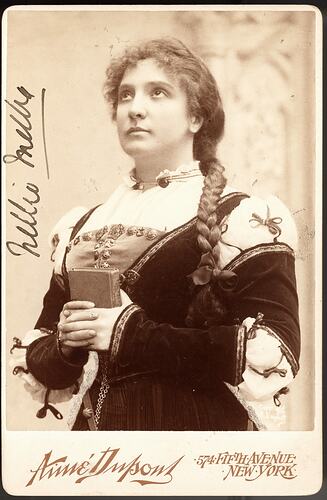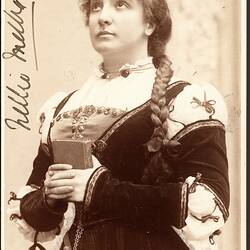Summary
Cabinet card featuring photograph of Dame Nellie Melba as Marguerite in 'Faust', and signed by Melba. It was produced by Aime Dupont, of 574 Fifth Ave, New York, around 1890.
The cabinet card was a style of photograph universally adopted for photographic portraiture in 1870 and over time reflects changing trends in photographic processes. It consisted of a thin photograph that was generally mounted on card. It replaced the carte de visite as a popular form of portraiture, the cabinet card being larger and usually included promotional information on the reverse side of the card to advertise the photographer's services. It was at its peak from the 1870s to the 1890s, until the public increasingly demanded outdoor and candid photographs with enlarged prints which they could frame or smaller unmounted snapshots they could collect in scrapbooks. The introduction of the relatively affordable Kodak Box Brownie in 1900 enabled people to take their own photos contributing to the declining popularity of the cabinet card. The last cabinet cards were produced in the 1920s.
Physical Description
Sepia-toned cabinet card photograph of Dame Nellie Melba with signature along top left hand side. The image has been mounted onto a cream card support with printed inscription along the bottom edge.
Significance
Dame Nellie Melba is one of Australia's most famous cultural icons and exports. Her operatic achievements were acknowledged both nationally and internationally and her World War I fundraising efforts earned her Dame Commander of the British Empire. These items enhance the Museum's modest collection relating to Melba by providing images of her in key operatic roles as well as demonstrating her fame and popularity through her featuring on souvenirs and company promotional collectables such as cabinet, trade and cigarette cards.
More Information
-
Collecting Areas
-
Acquisition Information
Purchase
-
Person Depicted
-
Inscriptions
Front: 'Aime Dupont 574 Fifth Avenue/ New York' Signature: 'Nellie Melba'
-
Classification
-
Category
-
Discipline
-
Type of item
-
Overall Dimensions
108 mm (Width), 165 mm (Height)
-
Keywords
Opera, Entertainers, Icons, Performing Arts, Performers, Performances, Music, Musical Performances


